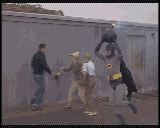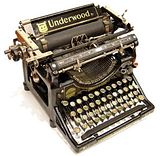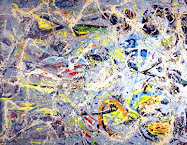
Last year, The Colorist inaugurated a new award in the spirit of "top ten" lists, named the Top Ten Art Blog Posts of the year. Posts that made this list were memorable, displayed one or more noteworthy pieces of art, or had expository merit.
What influenced me the most in my choices of the best post of the art blogging year 2009, was the quality of the posts as blogged. That is to say, they were great blogs - they had content so meaty you could chew on them. They stayed in my memory and lingered there. The artists made me want to write, post or paint as well as they did!
Awardees are welcome to copy and paste the medal jpeg. No attribution is necessary.
Here, then, are my choices for the year 2009, Top Ten Art Blog Posts.
Milton Caniff's Studio
February 28, 2009
Gurney Journey, James Gurney
Boyhood memories, task-oriented studio layouts and dreams. This post influenced me when I had an illustration assignment this year.
"Milton Caniff laid out his studio..."
My Father Asks for Nothing
March 3, 2009
Sippican Cottage, Gregory Sullivan
Respects. As seen through the eyes of his son, a WW II veteran relives, reluctantly but with quiet intensity, his days as a serviceman. Bring a Kleenex and use it. And if you don't need it, kick yourself in the ass.
"He rarely spoke about that. My father and his confreres considered themselves part of a thing greater than the sum of their parts in it..."
Stephen Haller: Remembering Morandi
March 31, 2009
Joanne Mattera Art Blog, Joanne Mattera
Mattera interviews Haller; Haller reminisces about the Italian master.
"...after that school year I set out to find Morandi in Bologna."
Opening Tonight at the Howard/Mandville Gallery
May 9, 2009
A Painting Today, Karen Jurick
This slide show of Jurick's exhibit, set to a Dean Martin track, gave me a vision for musical content in a blog post that is clear, and topical. It is an example of music illuminating painting. And it swings!
Leonard Cohen, Courtesy of Barney Davey, from Art Print Issues
May 23, 2009
Ancient Artist: Developing an art career after 50, Sue Favinger Smith
Age-immaterial powers. I wanted music on my blog after seeing this one.
Modigliani Madness
July 16, 2009
Museworthy, Claudia Hajian
Claudia's post from June 18, 2008, Modigliani’s Muse – Jeanne Hebuterne and the “Rock Star” of Montparnasse, was a bell weather post for her blog, and sets the scene for Modigliani Madness. Tragic, funny and illuminating - Claudia's posts will fascinate you on many levels.
"Fortunately not every woman who crossed paths with Modigliani had her life devastated."
Klimt
Gustav Klimt Kiss Vienna
July 19, 2009
Fine Art by Kelly Borsheim, Kelly Borsheim
Unique, individual criticism of the masterwork.
"I had the distinct impression that she had just died."
Old Drawings #39
Boogie Street, Harry Bell
July 27, 2009
Harry's three artworks entitled Sunday Market, which are a charcoal drawing, a collage of mixed media, and finally an oil painting, reveal his process visually. The painting actually comes out stronger than the already awesome drawing, which is a a sign of mastery.
Love at First Sight
July 28, 2009
Loriann Signori's Painting a Day, Loriann Signori
A magical trip to Washington State, where Loriann live-blogged her workshop with master pastelist and teacher Richard McKinley. I chose this piece as my favorite, and you should take the time to read through all of her July posts to experience her "nirvana" experience of outdoor painting.
Working on the Same Subject in Different Media
October 23, 2009
My French Easel, Benoit Philippe
The same scene, done three independent times in watercolor, then in pastel and then in oils.

















































